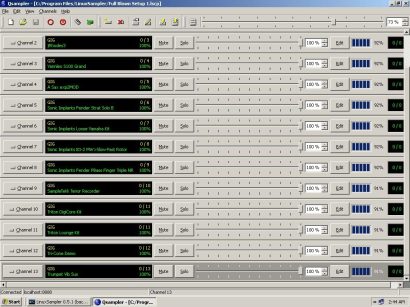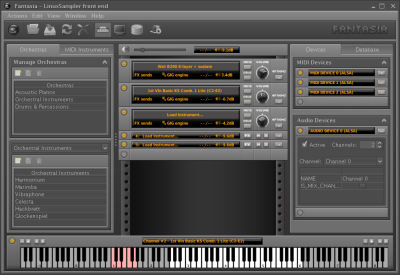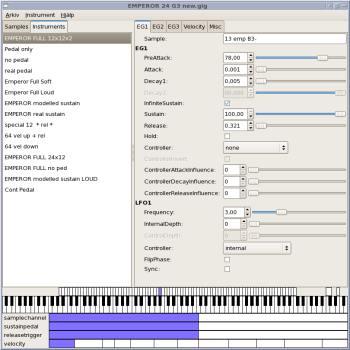
The LinuxSampler Project
 about about | |
|---|---|














|
The ProjectThe LinuxSampler project was founded with the goal to produce a free, streaming capable open source pure software audio sampler with professional grade features, comparable to both hardware and commercial Windows/Mac software samplers and to introduce new features not yet available by any other sampler in the world. The Engine
LinuxSampler was designed very modular, especially
(and in contrast to other samplers) it was decoupled from any user
interface. LinuxSampler itself usually runs as own process in the
background of the computer and usually does not show up anything on
the screen, or at most it can be launched to show status
informations and debug messages in a console window: The Face(s)
Obviously you need some way to control the sampler. That's where a
2nd application comes into game, which we call a
sampler frontend application. A frontend is (usually) a
graphical application, visible on the screen, providing the user
a set of e.g. menus, buttons, sliders, dials, etc. to allow the
user to control the sampler in a convenient way. It merely sends
the user requests to the sampler engine (LinuxSampler) and in turn
shows the engine's status informations on the screen. A frontend
does not perform any signal processing tasks, so you can see it as
a "face" of the sampler.
It's completely up to you which frontend to use. You could even use both parallel at the same time for the same sampler engine instance, really! ;-) You're concerned that your sampler frontend might waste precious resources of your computer? No problem, just setup the sampler session for your needs and then quit the frontend application. The sampler engine doesn't care! It continues to do its job. You need to change something? Start the frontend again (or another frontend) and you see what you expect to see: the current setup and state of the running sampler engine. The FormatIt is planned to support all common sampler formats in LinuxSampler, but at the moment we chose to concentrate on the Gigasampler format, because when we started this project, the Gigasampler format was (in our opinion) the most popular and "best" sampler format in regards of quality and power, especially for the synthesis of natural instruments like pianos, brass and bowed instruments. But we already made good advance in implementing this format, so we are optimistic to start with adding other formats soon. Beside that we also planned to design our own, sophisticated sampler format to introduce a more powerful and more flexible sampler format compared to any sampler format currently available in the world. Be encouraged to share your ideas about such a new format with us! The Editor
gigedit allows you to edit and create instruments
for the Gigasampler format, which can be used with LinuxSampler
as well as with Tascam's Gigastudio. Following our line of
modularity we also made the instrument editors independent
applications. Because let's face it: every sampler format is
different, so in our opinion it is better to honor the specific
features of one format with its own instrument editor application
instead of trying to fiddle everything into one single bloated
application. So gigedit is our first editor, dedicated to the .gig
format: The Technical Interface
As the components of the sampler are independent applications,
there must be a way to let the applications communicate with each
other. For this LinuxSampler provides a native C++
API
as well as a network interface using an ASCII based protocol which
we call "LSCP"
for controlling the sampler engine and managing sampler sessions.
Our frontends support that network interface, which also allows to
control the sampler engine with the GUI frontend(s) remotely from
another computer, probably even running a completely different
Operating System. And compared to other remote control solutions,
the frontend won't feel sluggish, as the frontend is running on
your local machine. The CompatibilityLinuxSampler is available for the most popular operating systems and already supports a variety of audio and MIDI driver systems on each OS. It does not require any special dedicated device drivers from the sound card manufacturers, so you can also use it with cheap consumer cards. Due to its clean design the sampler can be ported to other operating systems and extended for further driver systems with a minimum of effort. So we're prepared for the future! The Community
You need a helping hand? You certainly get the answers on your
personal questions on our
web forum. |




